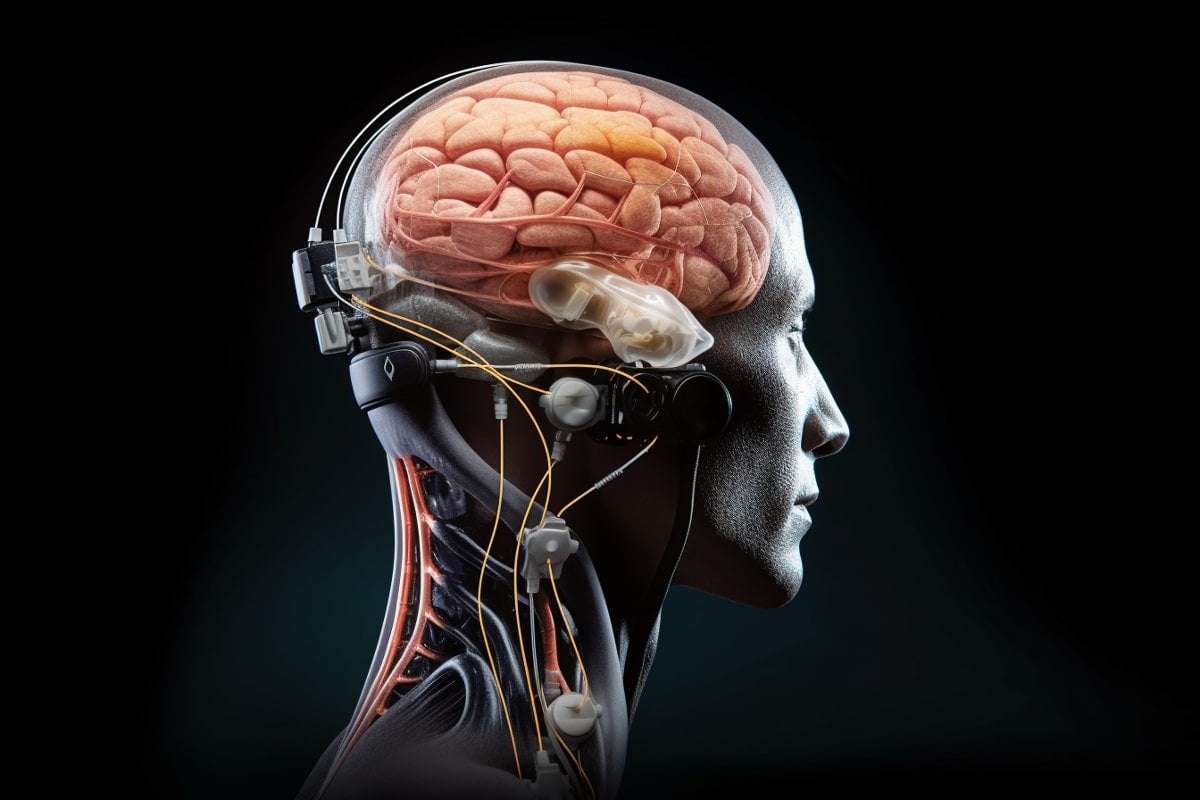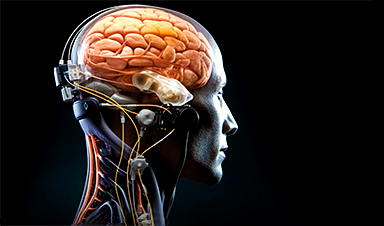Summary: In a pioneering study, researchers designed a wireless brain-spine interface enabling a paralyzed man to walk naturally again. The ‘digital bridge’ comprises two electronic implants — one on the brain and another on the spinal cord — that decode brain signals and stimulate the spinal cord to activate leg muscles.
Remarkably, the patient experienced significant recovery in sensory perceptions and motor skills, even when the interface was off. The team hopes to extend the technology’s applications to include restoring arm and hand functions, and assisting stroke patients.
Key Facts:
- The brain-spine interface is composed of two electronic implants that work together to decode brain signals and stimulate the spinal cord, resulting in the activation of leg muscles and enabling natural movement.
- The patient experienced significant improvement in sensory perceptions and motor skills, indicating potential development of new nerve connections even when the interface was not active.
- The team plans to explore applications of the technology to restore other functions and assist stroke patients, and there are ongoing efforts to commercialize the technology globally through ONWARD Medical, in partnership with CEA and EPFL.
Source: EPFL
Neuroscientists and neurosurgeons from EPFL/CHUV/UNIL and CEA/CHUGA/UGA report in the journal Nature that they have re-established the communication between the brain and spinal cord with a wireless digital bridge, allowing a paralyzed person to walk again naturally.
“We have created a wireless interface between the brain and the spinal cord using brain-computer interface (BCI) technology that transforms thought into action.”, summarizes Grégoire Courtine, Professor of Neuroscience at EPFL, CHUV and UNIL. Published in the journal Nature,
“Walking naturally after spinal cord injury using a brain-spine interface” presents the situation of Gert-Jan, 40 years old, who suffered a spinal cord injury following a bicycle accident that left him paralyzed.“The digital bridge enabled him to regain natural control over the movement of his paralyzed legs, allowing him to stand, walk, and even climb stairs. Gert-Jan explains that he has recovered the pleasure of being able to share a beer standing at a bar with friends : “This simple pleasure represents a significant change in my life”.
A digital bridge involving two electronic implants: one on the brain, the other on the spinal cord
To establish this digital bridge, two types of electronic implants are needed. Neurosurgeon Jocelyne Bloch, who is a professor at CHUV, UNIL and EPFL, explains: “We have implanted WIMAGINE® devices above the region of the brain that is responsible for controlling leg movements.
“These devices developed by the CEA allows to decode the electrical signals generated by the brain when we think about walking. We also positioned a neurostimulator connected to an electrode array over the region of the spinal cord that controls leg movement.
Guillaume Charvet, head of the BCI program at CEA, adds: “Thanks to algorithms based on adaptive artificial intelligence methods, movement intentions are decoded in real time from brain recordings.”
These intentions are then converted into sequences of electrical stimulation of the spinal cord, which in turn activate leg muscles to achieve the desired movement. This digital bridge operates wirelessly, allowing the patient to move around independently.
Recovery of neurological functions
Rehabilitation supported by the digital bridge enabled Gert-Jan to recover neurological functions that he had lost since his accident.
Researchers were able to quantify remarkable improvements in his sensory perceptions and motor skills, even when the digital bridge was switched off. This digital repair of the spinal cord suggests that new nerve connections have developed.

At this stage, the digital bridge has only been tested in one person. Jocelyne Bloch and Grégoire Courtine explain that, in the future, a comparable strategy could be used to restore arm and hand functions.
They add that the digital bridge could also be applied to other clinical indications, such as paralysis due to stroke.
The company ONWARD Medical, along with CEA and EPFL has received support from the European Commission trough its European Innovation Council (EIC) to develop a commercial version of the digital bridge, with the goal of making the technology available worldwide.
News
AI matches doctors in mapping lung tumors for radiation therapy
In radiation therapy, precision can save lives. Oncologists must carefully map the size and location of a tumor before delivering high-dose radiation to destroy cancer cells while sparing healthy tissue. But this process, called [...]
Scientists Finally “See” Key Protein That Controls Inflammation
Researchers used advanced microscopy to uncover important protein structures. For the first time, two important protein structures in the human body are being visualized, thanks in part to cutting-edge technology at the University of [...]
AI tool detects 9 types of dementia from a single brain scan
Mayo Clinic researchers have developed a new artificial intelligence (AI) tool that helps clinicians identify brain activity patterns linked to nine types of dementia, including Alzheimer's disease, using a single, widely available scan—a transformative [...]
Is plastic packaging putting more than just food on your plate?
New research reveals that common food packaging and utensils can shed microscopic plastics into our food, prompting urgent calls for stricter testing and updated regulations to protect public health. Beyond microplastics: The analysis intentionally [...]
Aging Spreads Through the Bloodstream
Summary: New research reveals that aging isn’t just a local cellular process—it can spread throughout the body via the bloodstream. A redox-sensitive protein called ReHMGB1, secreted by senescent cells, was found to trigger aging features [...]
AI and nanomedicine find rare biomarkers for prostrate cancer and atherosclerosis
Imagine a stadium packed with 75,000 fans, all wearing green and white jerseys—except one person in a solid green shirt. Finding that person would be tough. That's how hard it is for scientists to [...]
Are Pesticides Breeding the Next Pandemic? Experts Warn of Fungal Superbugs
Fungicides used in agriculture have been linked to an increase in resistance to antifungal drugs in both humans and animals. Fungal infections are on the rise, and two UC Davis infectious disease experts, Dr. George Thompson [...]
Scientists Crack the 500-Million-Year-Old Code That Controls Your Immune System
A collaborative team from Penn Medicine and Penn Engineering has uncovered the mathematical principles behind a 500-million-year-old protein network that determines whether foreign materials are recognized as friend or foe. How does your body [...]
Team discovers how tiny parts of cells stay organized, new insights for blocking cancer growth
A team of international researchers led by scientists at City of Hope provides the most thorough account yet of an elusive target for cancer treatment. Published in Science Advances, the study suggests a complex signaling [...]
Nanomaterials in Ophthalmology: A Review
Eye diseases are becoming more common. In 2020, over 250 million people had mild vision problems, and 295 million experienced moderate to severe ocular conditions. In response, researchers are turning to nanotechnology and nanomaterials—tools that are transforming [...]
Natural Plant Extract Removes up to 90% of Microplastics From Water
Researchers found that natural polymers derived from okra and fenugreek are highly effective at removing microplastics from water. The same sticky substances that make okra slimy and give fenugreek its gel-like texture could help [...]
Instant coffee may damage your eyes, genetic study finds
A new genetic study shows that just one extra cup of instant coffee a day could significantly increase your risk of developing dry AMD, shedding fresh light on how our daily beverage choices may [...]
Nanoneedle patch offers painless alternative to traditional cancer biopsies
A patch containing tens of millions of microscopic nanoneedles could soon replace traditional biopsies, scientists have found. The patch offers a painless and less invasive alternative for millions of patients worldwide who undergo biopsies [...]
Small antibodies provide broad protection against SARS coronaviruses
Scientists have discovered a unique class of small antibodies that are strongly protective against a wide range of SARS coronaviruses, including SARS-CoV-1 and numerous early and recent SARS-CoV-2 variants. The unique antibodies target an [...]
Controlling This One Molecule Could Halt Alzheimer’s in Its Tracks
New research identifies the immune molecule STING as a driver of brain damage in Alzheimer’s. A new approach to Alzheimer’s disease has led to an exciting discovery that could help stop the devastating cognitive decline [...]
Cyborg tadpoles are helping us learn how brain development starts
How does our brain, which is capable of generating complex thoughts, actions and even self-reflection, grow out of essentially nothing? An experiment in tadpoles, in which an electronic implant was incorporated into a precursor [...]





















